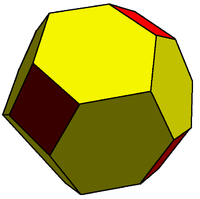Isogonal figure

In geometry, a polytope (a polygon, polyhedron or tiling, for example) is isogonal or vertex-transitive if all its vertices are the same. That is, each vertex is surrounded by the same kinds of face in the same order, and with the same angles between corresponding faces.
Technically, we say that for any two vertices there exists a symmetry of the polytope mapping the first isometrically onto the second. Other ways of saying this are that the polytope is transitive on its vertices, or that the vertices lie within a single symmetry orbit.
The term isogonal has long been used for polyhedra. Vertex-transitive is a synonym borrowed from modern ideas such as symmetry groups and graph theory.
Isogonal polygons

All regular polygons and regular star polygons are isogonal.
Some even-sided polygons which alternate two edge lengths, for example rectangle, are isogonal.
All such 2n-gons have dihedral symmetry (Dn, n=2,3,...) with reflection lines across the mid-edge points.
Isogonal polyhedra
Isogonal polyhedra may be classified:
- Regular if it is also isohedral (face-transitive) and isotoxal (edge-transitive); this implies that every face is the same kind of regular polygon.
- Quasi-regular if it is also isotoxal (edge-transitive) but not isohedral (face-transitive).
- Semi-regular if every face is a regular polygon but it is not isohedral (face-transitive) or isotoxal (edge-transitive). (Definition varies among authors; e.g. some exclude solids with dihedral symmetry, or nonconvex solids.)
- Uniform if every face is a regular polygon, i.e. it is regular, quasiregular or semi-regular.
- Noble if it is also isohedral (face-transitive).
An isogonal polyhedron has a single kind of vertex figure. If the faces are regular (and the polyhedron is thus uniform) it can be represented by a vertex configuration notation sequencing the faces around each vertex.
Isogonal polytopes and tessellations
These definitions can be extended to higher dimensional polytopes and tessellations. Most generally, all uniform polytopes are isogonal, for example, the uniform polychorons and convex uniform honeycombs.
The dual of an isogonal polytope is called an isotope which is transitive on its facets.
k-isogonal figures
A polytope or tiling may be called k-isogonal if its vertices form k transitivity classes.
 This truncated rhombic dodecahedron is 2-isogonal because it contains two transitivity classes of vertices. This polyhedron is made of squares and flattened hexagons. |
 This demiregular tiling is also 2-isogonal. This tiling is made of equilateral triangle, square and regular hexagonal faces. |
A more restrictive term, k-uniform figures is defined as an k-isogonal figure constructed only from regular polygons. They can be represented visually with colors by different uniform colorings.
References
- Peter R. Cromwell, Polyhedra, Cambridge University Press 1997, ISBN 9-521-55432-2, p.369 Transitivity
- Grünbaum, Branko; Shephard, G. C. (1987). Tilings and Patterns. W. H. Freeman and Company. ISBN 0-7167-1193-1.
{{cite book}}: CS1 maint: multiple names: authors list (link) (p. 33 k-isogonal tiling, p.65 k-uniform tilings)
See also
- Edge-transitive (Isotoxal figure)
- Face-transitive (Isohedral figure)
External links
- Weisstein, Eric W. "Vertex-transitive graph". MathWorld.
- Olshevsky, George. "Transitivity". Glossary for Hyperspace. Archived from the original on 4 February 2007.
- Olshevsky, George. "Isogonal". Glossary for Hyperspace. Archived from the original on 4 February 2007.
- Isogonal Kaleidoscopical Polyhedra Vladimir L. Bulatov, Physics Department, Oregon State University, Corvallis, Presented at Mosaic2000, Millennial Open Symposium on the Arts and Interdisciplinary Computing, 21-24 August, 2000, Seattle, WA
- Steven Dutch uses the term k-uniform for enumerating k-isogonal tilings
- List of n-uniform tilings
- Weisstein, Eric W. "Demiregular tessellations". MathWorld. (Also uses term k-uniform for k-isogonal)
